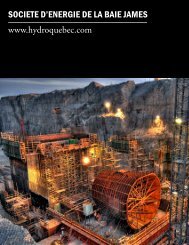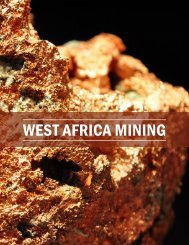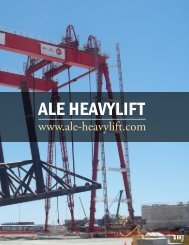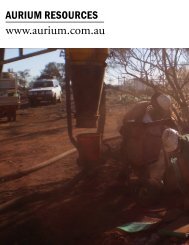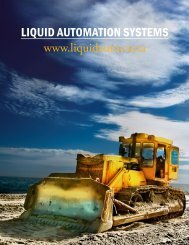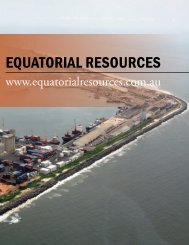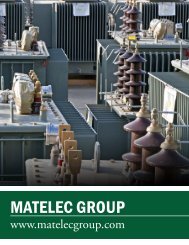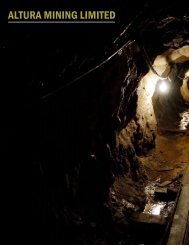INTEX RESOURCES - The International Resource Journal
INTEX RESOURCES - The International Resource Journal
INTEX RESOURCES - The International Resource Journal
You also want an ePaper? Increase the reach of your titles
YUMPU automatically turns print PDFs into web optimized ePapers that Google loves.
Intex <strong>Resource</strong>s<br />
www.intexresources.com.ph/mindoronickel
2 ASIA AND THE MIDDLE EAST Intex <strong>Resource</strong>s<br />
2<br />
Intex R<br />
Seeing green
MAY 2012 <strong>The</strong> <strong>International</strong> <strong>Resource</strong> <strong>Journal</strong><br />
3<br />
Asia and the Middle East<br />
esources
4 ASIA AND THE MIDDLE EAST Intex <strong>Resource</strong>s<br />
Intex <strong>Resource</strong>s’ big ambitions to start<br />
a green nickel mining operation in the<br />
Philippines hinges upon attracting the<br />
right partners and negotiating with local<br />
communities<br />
“<strong>The</strong> most exciting thing about this deposit<br />
is that we have managed to make a low grade<br />
of less than one per cent economically feasible<br />
while planning a carbon-neutral mining operation,<br />
possibly the world’s first carbon-neutral<br />
Intex <strong>Resource</strong>s’ flagship Mindoro project has<br />
the kind of story many engineers love to hear. It<br />
intends to be a scalable, holistically designed system<br />
that incorporates green design into its moving<br />
parts, ultimately planning to deliver what might be<br />
the world’s first carbon neutral mining project.<br />
Located in the central part of the island of<br />
Mindoro in the Philippines lie some 300-million<br />
tonnes of mineral resources (defined to date), holding<br />
2.6-million tonnes of nickel. But the mineral<br />
resource is only a portion of the success story, says<br />
Jon Steen Petersen, interim president and CEO of<br />
the Oslo-listed company. Before taking on the role,<br />
Petersen had a career as associate professor in<br />
economic geology and geochemistry at the University<br />
of Oslo and Aarhus in Denmark.<br />
<strong>The</strong> other part of the story, he explains, is<br />
that special properties of the ore plus a definitive<br />
feasibility study with innovative green design has<br />
given Mindoro Nickel bragging rights to potentially<br />
the smallest carbon footprint of any nickel processing<br />
plant and one of the most cost-efficient<br />
per pound nickel production.<br />
nickel project with a near-zero carbon footprint,”<br />
says Petersen.<br />
<strong>The</strong> definitive feasibility study (DFS) shows<br />
the nickel production costs at $2.11/lb, allowing<br />
for between $5 and $6 margin per pound at current<br />
nickel prices, and not including the value of<br />
a series of by-products.<br />
An important part of Intex’s philosophy for<br />
the project is to maximise the use of all components<br />
in the process, including ore, consumables<br />
and waste products. Processing of the laterite<br />
ore will result in not only 53,000 tonnes per annum<br />
(tpa) nickel briquettes but also an estimated<br />
75,000 tpa metallurgical chromite from the<br />
limonite beneficiation plant. In addition, the operation<br />
will extract some 16,000 tpa cobalt as a<br />
sulphate salt, in a form that is applicable for electronic<br />
battery industries. Finally, some 150,000<br />
tonnes of ammonia sulphate, a prime fertiliser,<br />
will come as a by-product from the metals plant.<br />
“If you include chromite, cobalt and ammonium<br />
sulphate as by-products the cost will go<br />
from $2.11/lb to 53 cents, and there is even<br />
potential for adding rare earth elements and
MAY 2012 <strong>The</strong> <strong>International</strong> <strong>Resource</strong> <strong>Journal</strong><br />
5<br />
JCP GEO-EX SERVICES, INC.<br />
Services Offered:<br />
Single Tube and Triple Tube Core Drilling<br />
Modified Banka Drilling on Sand<br />
Onshore and Offshore Geotech Drilling<br />
Related Geological and Geodetic Services<br />
- ISO 9001:2008 Certified<br />
- a DENR/MGB-accredited<br />
service provider specializing<br />
primarily in Ni-laterite drilling<br />
- 5S Practitioner<br />
- guaranteed 95% core recovery<br />
Contact Person:<br />
MR. JESUS C. PALMA JR.<br />
Calderon Compound, Banawa<br />
Cebu City, Philippines<br />
TeleFax: (032) 262-5398 / 272-7560<br />
Mobile: 09176243786<br />
Email: jcpgeo2003@yahoo.com<br />
www.jgsi.com.ph<br />
Recent Projects:<br />
Regency Mines PLC (Papua New Guinea)<br />
Intex <strong>Resource</strong>s Philippines, Inc.<br />
QNI Philippines<br />
CMGVI Mining Ventures Corporation<br />
Sinosteel Philippines H.Y. Mining Corp<br />
/ HY Chromite Mining and Dev Corp.<br />
MRL Gold Philippines, Inc.<br />
Philnico Mining and Industrial Corporation<br />
Harita Group of Companies(Indonesia)<br />
Forum Cebu Coal Corporation<br />
Benguet Corporation<br />
BHP Billiton<br />
Rusina Nickel NL (HQ3)<br />
Ipilan Nickel Corporation<br />
Berong Nickel Corporation<br />
Macroasia Corporation<br />
scandium to the production from the leached<br />
solutions. We have done test work to show that<br />
we can extract these minerals economically,<br />
and potentially produce 100 tonnes of scandium<br />
per year, which is more than the world’s<br />
current production,” he adds.<br />
‘Green’ limits<br />
Still, some cold hard realities have to be taken<br />
into account. CAPEX was estimated at some $2.4<br />
billion in the original DFS, which is clearly a tall<br />
order for a greenfield project in today’s global<br />
economics. Far from being discouraging, Petersen<br />
explains that implementing the project in<br />
three stages would provide distinct advantages<br />
in addition to taking the target CAPEX down to<br />
$800 million for the first stage, which is a much<br />
more manageable amount.<br />
“We decided to redesign the project, still<br />
maintaining the maximum size as the ultimate<br />
goal, but starting with a first stage that would<br />
produce about 18,000 tonnes per day (t/d) for<br />
$800 million and suddenly we were in a totally<br />
different ball game when it comes to financing,<br />
as early cash flow can be established. We<br />
wanted to maintain all the design benefits but<br />
to build the plant in segments, using smaller<br />
units, and with the option to allow bypass of
6 ASIA AND THE MIDDLE EAST Intex <strong>Resource</strong>s<br />
individual components during maintenance of<br />
such units,” he explains.<br />
<strong>The</strong> deposit itself consists of two principally<br />
different laterite ore types: limonite and saprolite<br />
ore. <strong>The</strong> limonite is enriched in nickel and cobalt<br />
and can be successfully processed by high-pressure<br />
acid leach technology because of its high<br />
iron content, whereas saprolite ore is low in iron<br />
and generally considered better suited for other<br />
processing techniques.<br />
“Traditionally, saprolite and limonite ores<br />
are not processed together; saprolite is usually<br />
taken to smelters, whereas limonite is processed<br />
with hydrometallurgical methods, but<br />
we have studied this and after successful test<br />
work found that it is possible to process both<br />
ore types economically using hydrometallurgy<br />
methods, only” Petersen explains.<br />
Because saprolite is magnesium-rich, hydrometallurgical<br />
processing in atmospheric pressure<br />
tanks will require about twice the amount of acid<br />
than the limonite circuit. However, more acid also<br />
means more waste heat and an acid plant, which<br />
converts native sulphur to sulphuric acid, can be<br />
used to the company’s advantage in generating<br />
electricity. Based on the full size plant design,<br />
the steam from the acid plant can generate<br />
110MW of carbon-free electrical power.
MAY 2012 <strong>The</strong> <strong>International</strong> <strong>Resource</strong> <strong>Journal</strong><br />
7<br />
“<strong>The</strong> trick is the acid plant will generate not<br />
only all the acid and steam we need for bringing<br />
fluids around in the processing plant, but also<br />
provides all the electricity we need, including<br />
what is required to transport the ore from the<br />
mine to the plant near the coast, and all carbon<br />
free and ndependent on fossil fuels, and this is<br />
significant because you can imagine – six-million<br />
tonnes for the full-sized plant or two-million<br />
tonnes for the small – trucks for this transport<br />
would eat a lot of diesel. We don’t have to buy<br />
diesel for this because we will transport the ore<br />
via cable conveyors from the mine site to the<br />
plant site,” Petersen says.<br />
Match-making<br />
Intex <strong>Resource</strong>s is now looking for partners to<br />
build a consortium that can provide the project<br />
with engineering and operational experience. “A<br />
competent EPC contractor can make a significant<br />
difference on the project. In addition to engineering<br />
and operational experience, we are also looking for<br />
partners, who are interested in off-take or end-use<br />
of the products and are interested in taking part<br />
in making this exciting project happen,” Petersen<br />
says. <strong>The</strong> consortium is also looking for bringing in<br />
a major Philippine industrial partner.<br />
Intex <strong>Resource</strong>s has recently signed an MOU<br />
with MCC8, a major metallurgical construction<br />
group in China, to establish a consortium for<br />
Mindoro Nickel. MCC8 used to be the main nickel<br />
company in the country, but Jinchuan, now Chinas<br />
largest nickel company, was spun out and<br />
MCC8 remained the engineering arm for the nickel<br />
industry, but also developed new directions.<br />
“MCC8 is one of those examples of a<br />
partner that might not seem the most obvious,<br />
being primarily an engineering group, but they<br />
have started getting involved in green projects<br />
worldwide, with clean technology and watercleaning<br />
projects in Africa and elsewhere, and<br />
this is very appealing. Here is a Chinese company<br />
that wants to show that things can be done<br />
green and are just as excited about the potential<br />
of a “green” carbon-neutral mining project as we<br />
are,” Petersen says.<br />
If a proper consortium can be brought together<br />
to help realise the Mindoro project, Intex <strong>Resource</strong>s<br />
is prepared to offer 90-per-cent share to<br />
the consortium. “We are first and foremost mine<br />
developers, not mine operators, so we would like<br />
to see this project happen, so we can find and<br />
develop the next big project – this is what we do<br />
best,” he adds.<br />
<strong>The</strong> company’s next big project could well be<br />
a significant molybdenum deposit in Norway, but<br />
Petersen does not want to get ahead of himself.<br />
If a Mindoro consortium can be established
8 ASIA AND THE MIDDLE EAST Intex <strong>Resource</strong>s
MAY 2012 <strong>The</strong> <strong>International</strong> <strong>Resource</strong> <strong>Journal</strong><br />
9<br />
soon, possibly with financing along with it, then<br />
construction of the first stage could take approximately<br />
two years targeting a production<br />
from 2014. At the moment, the nickel market is<br />
volatile and much affected by pig-iron production<br />
based on high-grade laterite ore from Indonesia<br />
and the Philippines, which today accounts for<br />
some 50 per cent of China’s nickel consumption.<br />
However, the high energy- costs of this process<br />
coupled with resources restrictions and coming<br />
export ban will eventually deplete this market,<br />
potentially leading to a market deficiency, explains<br />
Petersen.<br />
At the same time, the Philippines is located<br />
very centrally for resource-hungry neighbours<br />
such as China, Japan, Korea and India – which<br />
today consume over 60 per cent of the world’s<br />
nickel . At the same time, the Philippines is the<br />
natural domestic market for the by-product: ammonium<br />
sulphate which is a preferred fertiliser<br />
for rice and sugar cane in tropical climates.<br />
Community relations<br />
Mindoro Island’s economy has so far been dependent<br />
on traditional farming and fishing, and<br />
where powerful typhoons constantly cause destruction<br />
of seasonal crops and damage to local<br />
infrastructure, including roads and bridges.<br />
<strong>The</strong> island also suffers from frequent extensive<br />
flooding, which causes further aggravation of the<br />
already-vulnerable agro-based economy.<br />
While the development of a large industrial<br />
operation can bring a much-needed boost to<br />
the local economy, it understandably generates<br />
concern among the predominantly rural population,<br />
regarding the consequences for their traditional<br />
trades. <strong>The</strong> license area of approximately<br />
100km 2 is being used by about 200 indigenous<br />
Mangyan families for their traditional nomadic<br />
lifestyle. Intex has established a close relationship<br />
with these communities and assisted<br />
through community relation programs, including<br />
a potable water supply, medical assistance<br />
as well as educational and capacity building<br />
programs in agroforestry and farming. During<br />
exploration campaigns, the Mangyans population<br />
is employed on an equal basis with other locals,<br />
and often in a rotary system, to ensure a maximum<br />
of interested people will receive the benefits<br />
of this engagement.<br />
“About the time we arrived in 1997, the Indigenous<br />
Peoples Rights Act had just been launched<br />
and for first time granted the Indigenous people<br />
rights to their ancestral land. Since then the<br />
implementation has been ongoing and gradually<br />
completed – basically providing these people<br />
with an identity and a legal protection to and title<br />
to their land,” says Petersen.
10 ASIA AND THE MIDDLE EAST Intex <strong>Resource</strong>s<br />
<strong>The</strong> company has signed agreements with<br />
the affected population and focused on medical,<br />
educational and agricultural CSR commitments,<br />
for example, the establishment of spring-fed<br />
water systems that are now in multiple villages<br />
benefiting some 10,000 people.<br />
“Mining today is not just a technical issue,<br />
mining today is as much a social engagement<br />
programme that helps local people to utilise and<br />
get benefits from their resources…many people<br />
are sceptical and believe that they will not get<br />
the benefits, as this often happened in the past .<br />
I think this is where we still have to showcase it.<br />
Legislation has changed very much over the last<br />
30 years and everybody in the mining industry today<br />
understands the need of social engagement<br />
in connection with the exploitation of all natural<br />
resources,” Petersen adds.<br />
Despite his assurances that the company<br />
has the best intentions of the community in<br />
mind, there is a vocal resistance and scepticism<br />
towards Intex’s plans in the area. Anti-mining<br />
groups aligned with Norwegian NGO’s have accused<br />
Intex of breaches of OECD guidelines. In<br />
general, mining has a disreputable past in the<br />
Philippines as a result of environmental degradation<br />
from previous operations. Though cleared<br />
of any wrong-doing, some outstanding issues of<br />
non-compliance were identified by a Norwegian<br />
government investigation, which the company<br />
has promised to improve. Intex has pointed out<br />
that the OECD guidelines in question are within<br />
the context of operating companies and the company<br />
plans on following all of those rules when<br />
operations at the site commence, a viewpoint<br />
backed by a UK-led commission which also found<br />
no evidence of bribery allegations made against<br />
Intex, Petersen notes.<br />
“We are not under criminal investigation and<br />
we are not under suspicion of having broken<br />
any laws. In fact we have been met with such<br />
accusations in over 12 years from anti-mining<br />
groups and obviously made every effort to strictly<br />
operate under government compliance and had<br />
a dozen Philippine clearances from national<br />
authorities, in response to various accusations,”<br />
explains Petersen.<br />
“Where indigenous people have special<br />
rights overriding the national legislation, we have<br />
followed the advice of the national commission for<br />
Indigenous people, which serves as a government<br />
agency charged with protecting indigenous peoples’<br />
interest. We follow their advice about who to deal<br />
with since only 200 families live inside the area<br />
affected by our planned mining operations. This is<br />
a very delicate issue, absolutely,” he says. “We wish<br />
partnership with the host communities in pursuing<br />
local and national development and will be
MAY 2012 <strong>The</strong> <strong>International</strong> <strong>Resource</strong> <strong>Journal</strong><br />
11<br />
transparent and diligent in our obligations (taxes) to<br />
the local and national governments.”<br />
Petersen points out that most mining projects<br />
in the Philippines are facing similar fierce opposition<br />
and it is also seen in many other parts of the<br />
world. <strong>The</strong> company plans to take each issue in<br />
stride and respond appropriately to any allegations.<br />
“It is a negotiation. We have discovered a<br />
significant, substantial deposit. We have found a<br />
way to utilise that deposit in an economical manner,<br />
using new technologies in pursuing responsible<br />
and green mining. What we are now trying to do is<br />
realise it and part of that is to obtain social acceptability.<br />
Our focus now has to be about explaining to<br />
people what the risk and benefits are, it has to be a<br />
democratic selective process...and in that process<br />
we will find a period of debate and discussion, of<br />
scepticism and fear,” Petersen says.<br />
www.intexresources.com.ph/mindoronickel
AS SEEN IN THE MAY 2012 ISSUE<br />
OF THE INTERNATIONAL RESOURCE JOURNAL







